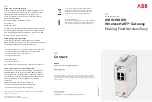
Chapter 5 WAN Setup
VMG1312-T10C User’s Guide
36
• Use the
More Connections
screen (
) to set up additional Internet access
connections.
• Use the
3G Backup
screen to configure 3G WAN connection (
).
5.1.2 What You Need to Know About WAN
Encapsulation Method
Encapsulation includes data from an upper layer protocol into a lower layer protocol. To set up a
WAN connection to the Internet, you need to use the same encapsulation method used by your ISP
(Internet Service Provider). If your ISP offers a dial-up Internet connection using PPPoE (PPP over
Ethernet) or PPPoA, they should also provide a username and password (and service name) for user
authentication.
WAN IP Address
The Device uses its WAN IP address to connect to the Internet and communicate with devices in
other networks. It can be static (fixed) or dynamically assigned by the ISP when the Device
connects to the Internet.
If your ISP assigns you a static WAN IP address, they should also assign you the subnet mask and
DNS server IP address(es) (and a gateway IP address if you use the Ethernet or ENET ENCAP
encapsulation method).
Multicast
Traditionally, IP packets are transmitted in one of either two ways - Unicast (1 sender - 1 recipient)
or Broadcast (1 sender - everybody on the network). Multicast delivers IP packets to a group of
hosts on the network - not everybody and not just one.
IGMP
Devices use the IGMP (Internet Group Management Protocol) network-layer protocol to establish
membership in a multicast group - it does not carry user data. IGMP versions 2 and 3 offer
improvements over the widely-used version 1.
IPv6
IPv6 (Internet Protocol version 6) provides increased IP address space and enhanced features in
comparison to IPv4. The Device supports IPv4/IPv6 dual stack and can connect to IPv4 and IPv6
networks.
IPv6 Rapid Deployment
Use IPv6 Rapid Deployment (6rd) when the local network uses IPv6 and the ISP has an IPv4
network. When the Device has an IPv4 WAN address and you set
IPv6/IPv4 Dual Stack
to
IPv4
,
you can enable 6rd to encapsulate IPv6 packets in IPv4 packets to cross the ISP’s IPv4 network.
The Device generates a global IPv6 prefix from its IPv4 WAN address and tunnels IPv6 traffic to the
ISP’s Border Relay router (BR in the figure) to connect to the native IPv6 Internet. The local
Содержание VMG1312-T10C
Страница 4: ...Contents Overview VMG1312 T10C User s Guide 4 ...
Страница 12: ...Table of Contents VMG1312 T10C User s Guide 12 ...
Страница 13: ...13 PART I User s Guide ...
Страница 14: ...14 ...
Страница 20: ...Chapter 1 Introduction VMG1312 T10C User s Guide 20 ...
Страница 28: ...28 ...
Страница 34: ...Chapter 4 Connection Status and System Info VMG1312 T10C User s Guide 34 ...
Страница 39: ...Chapter 5 WAN Setup VMG1312 T10C User s Guide 39 Figure 19 Network Setting Broadband Internet Connection ...
Страница 106: ...Chapter 7 Home Networking VMG1312 T10C User s Guide 112 ...
Страница 144: ...Chapter 13 Filter VMG1312 T10C User s Guide 152 ...
Страница 164: ...Chapter 15 Parental Control VMG1312 T10C User s Guide 172 ...
Страница 172: ...Chapter 16 Certificates VMG1312 T10C User s Guide 180 ...
Страница 178: ...Chapter 17 System Monitor VMG1312 T10C User s Guide 186 ...
Страница 180: ...Chapter 18 User Account VMG1312 T10C User s Guide 188 ...
Страница 184: ...Chapter 20 System VMG1312 T10C User s Guide 192 ...
Страница 190: ...Chapter 22 Log Setting VMG1312 T10C User s Guide 198 ...
Страница 196: ...Chapter 24 Backup Restore VMG1312 T10C User s Guide 204 ...
Страница 208: ...Chapter 25 Remote Management VMG1312 T10C User s Guide 216 4 The command line interface displays ...
Страница 214: ...Chapter 26 Diagnostic VMG1312 T10C User s Guide 222 ...
Страница 232: ...Appendix B Legal Information VMG1312 T10C User s Guide 240 ...
















































